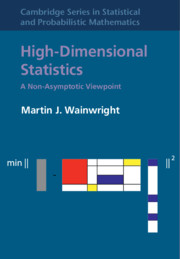Book contents
- Frontmatter
- List of chapters
- Contents
- Illustrations
- Acknowledgements
- 1 Introduction
- 2 Basic tail and concentration bounds
- 3 Concentration of measure
- 4 Uniform laws of large numbers
- 5 Metric entropy and its uses
- 6 Random matrices and covariance estimation
- 7 Sparse linear models in high dimensions
- 8 Principal component analysis in high dimensions
- 9 Decomposability and restricted strong convexity
- 10 Matrix estimation with rank constraints
- 11 Graphical models for high-dimensional data
- 12 Reproducing kernel Hilbert spaces
- 13 Nonparametric least squares
- 14 Localization and uniform laws
- 15 Minimax lower bounds
- References
- Subject index
- Author index
- References
References
Published online by Cambridge University Press: 12 February 2019
- Frontmatter
- List of chapters
- Contents
- Illustrations
- Acknowledgements
- 1 Introduction
- 2 Basic tail and concentration bounds
- 3 Concentration of measure
- 4 Uniform laws of large numbers
- 5 Metric entropy and its uses
- 6 Random matrices and covariance estimation
- 7 Sparse linear models in high dimensions
- 8 Principal component analysis in high dimensions
- 9 Decomposability and restricted strong convexity
- 10 Matrix estimation with rank constraints
- 11 Graphical models for high-dimensional data
- 12 Reproducing kernel Hilbert spaces
- 13 Nonparametric least squares
- 14 Localization and uniform laws
- 15 Minimax lower bounds
- References
- Subject index
- Author index
- References
- Type
- Chapter
- Information
- High-Dimensional StatisticsA Non-Asymptotic Viewpoint, pp. 524 - 539Publisher: Cambridge University PressPrint publication year: 2019



